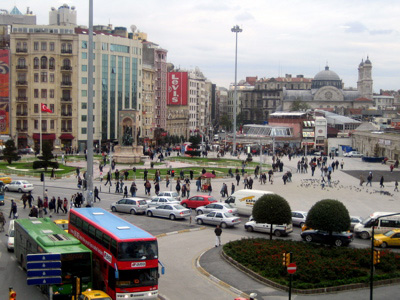Semester at Sea Fall
2006 Voyage
- Home Page
- My bio
- Multisited Ethnography Project
- Shipboard Interview with LR
- The Hawaiian Tour Guide
- A Rushed Day in Tokyo
- Yuen Long, Hong Kong
- Ben Trahn Market, Ho Chi Minh City
- A Typical Cultural Tour in Myanmar
- The Gaze of an Indian Boy
- Egyptian Students at the Pyramids
- Taksim Square, Istanbul
- Open Letter
Taksim Square, Istanbul
By Wren Chan

Turkey is said to be the country in which the East meets the West both physically and culturally. Indeed it lives up to that name in Istanbul, where the younger generation would dress up in the latest fashion and move around freely like in Europe and the United States and yet there would be others that adhere by a more conservative dress code and follow the traditions carefully. One such scene is Taksim Square where one can observe many people in line for the buses out of Istanbul to outlying regions and also couples and friends scrolling along Istiklal Avenue lined with Western stores and consulates. The air was chilly at this time of the year yet there were many people lined up to get onto the buses that were departing to various places like Izmir and Ankara. There were some primary school students that were amongst these travelers in Taksim Square in addition to couples and friends walking towards the Istiklal Avenue.
It was around 6:00 pm across the street from the internet café from which frame is taken from is a McDonald’s filled to the capacity with some vendors selling nuts to travelers awaiting their buses. Behind the McDonald’s was the square itself with some pockets of activity in within it consisting of friends and couples that were or planning to go shop in Istiklal Avenue. Noticeably absent was a mosque in the area which is noticeably more prevalent in other areas of Istanbul. From one of the subways in the square that led to the metro, more people arose either going to catch a bus out of Istanbul or going shopping. There were benches on which couples or friends usually sat on talking about whatever topics come to mind. Observing the women in the squares move in their own groups of similarly dressed companions evoked the work of Yael Navaro-Yasin who wrote on the very essence of the conflict between tradition and westernization and what it meant to be Turkish. A story that Navaro-Yasin used that came to mind was the one about two women standing in line to enter the Ayasofya museum thinking that the other was a foreigner. This example perhaps neatly fitted into the situation observed in which neither groups did much to interact with the other in the Square.
Taking a wider look at Taksim Square which sat on a hill above sea level, one would see the Old City with its old buildings, mosques, bazaars and crowded streets to the southwest while the area southeast of the Square is occupied by tall buildings that would be considered skyscrapers relative to the shorter buildings in Taksim Square. A football stadium is located on the foot of this hill while the palace of the Ottoman sultans lay across the street from the football stadium. The relative closeness of the buildings and districts seems to also confirm physically the dual identity that Turkey possesses a Western identity and an Islamic identity. It is important however to note that the Old City was still traditional in the sense that most of the stores are more geared towards catering to the local populace while the stores in Taksim are geared towards the younger and more Westernized populace.
I didn’t truly grasp this aspect of Istanbul until leaving due to the fact that I was rushing to get a souvenir and planning to return to the ship. Nonetheless the length and the number of people on Istiklal Avenue that night still left a major impression that at the very least a significant part of Turkey is very Western.